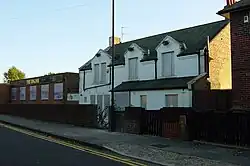Willington, Tyne and Wear
| Willington | |
|---|---|
 The Engine | |
 Willington Location within Tyne and Wear | |
| Metropolitan borough | |
| Metropolitan county | |
| Region | |
| Country | England |
| Sovereign state | United Kingdom |
| Post town | WALLSEND |
| Postcode district | NE28 |
| Dialling code | 0191 |
| Police | Northumbria |
| Fire | Tyne and Wear |
| Ambulance | North East |
Willington is an area in the North Tyneside district, in the county of Tyne and Wear, England. It has an industrial estate.
History
The place-name derives from Old English tun (homestead or farm) of Wifel's people, and appears in 1085 as Wiflintun, and as Wiuelington in 1204.[1]
Willington was formerly a township and chapelry in the parish of Walls-end,[2] on 30 September 1894 Willington became a separate civil parish, being formed from the rural part of Wallsend, on 9 November 1910 the parish was abolished and merged with Wallsend.[3] In 1901 the parish had a population of 1999.[4]
Folklore
Willington became famous in the mid nineteenth century because of a ghost associated with a corn mill there owned by Joseph Procter, a local quaker. Information about this celebrated haunting was gathered together in 1892 by Procter's son.[5]
References
- The geographic coordinates are from the Ordnance Survey.
- ^ Ekwall, Eilert, The Concise Oxford Dictionary of English Place-Names. Oxford, Oxford University Press, 4th edition, 1960. p. 520. ISBN 0198691033.
- ^ "History of Willington Quay, in North Tyneside and Northumberland". A Vision of Britain through Time. Retrieved 26 September 2024.
- ^ "Tynemouth Registration District". UKBMD. Retrieved 26 September 2024.
- ^ "Population statistics Willington CP/Tn through time". A Vision of Britain through Time. Retrieved 26 September 2024.
- ^ Edmund Procter, ‘The Haunted House at Willington’, Journal of the Society for Psychical Research 5 (Dec 1892), 331–48